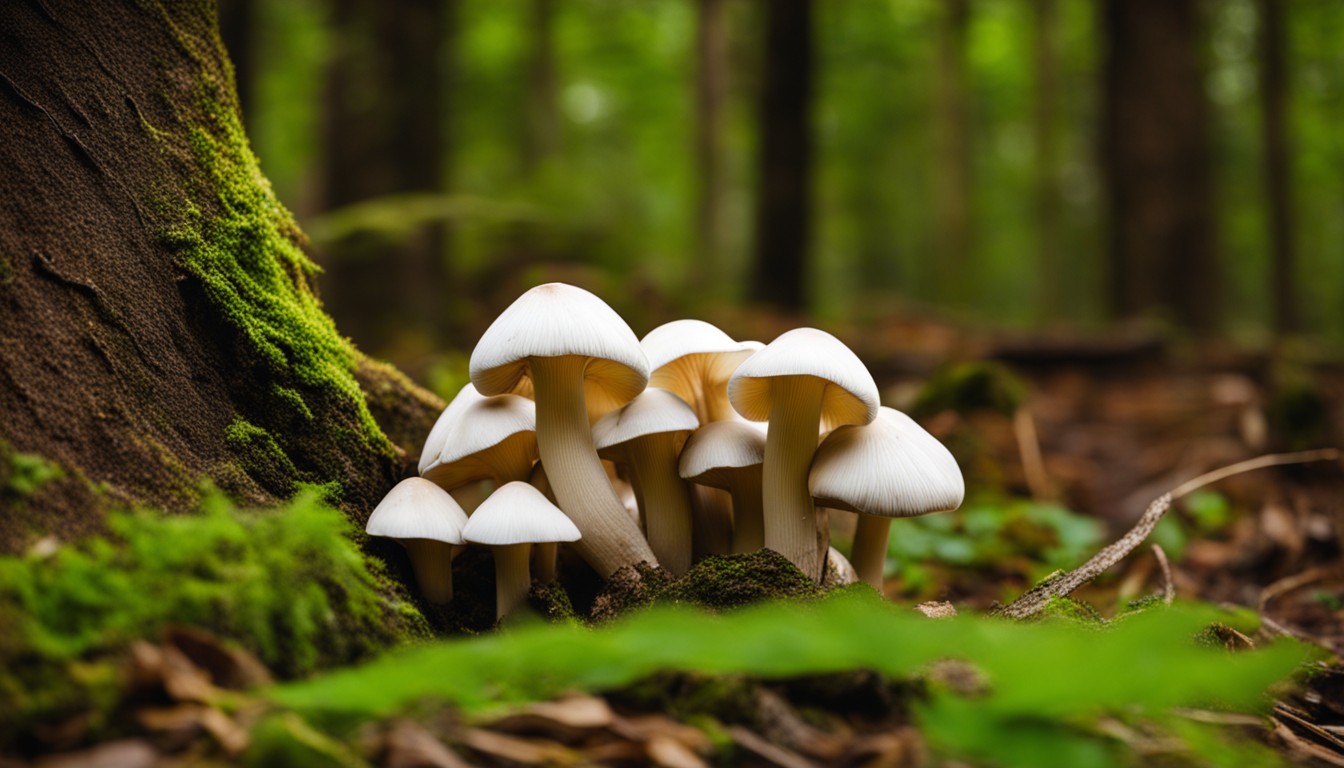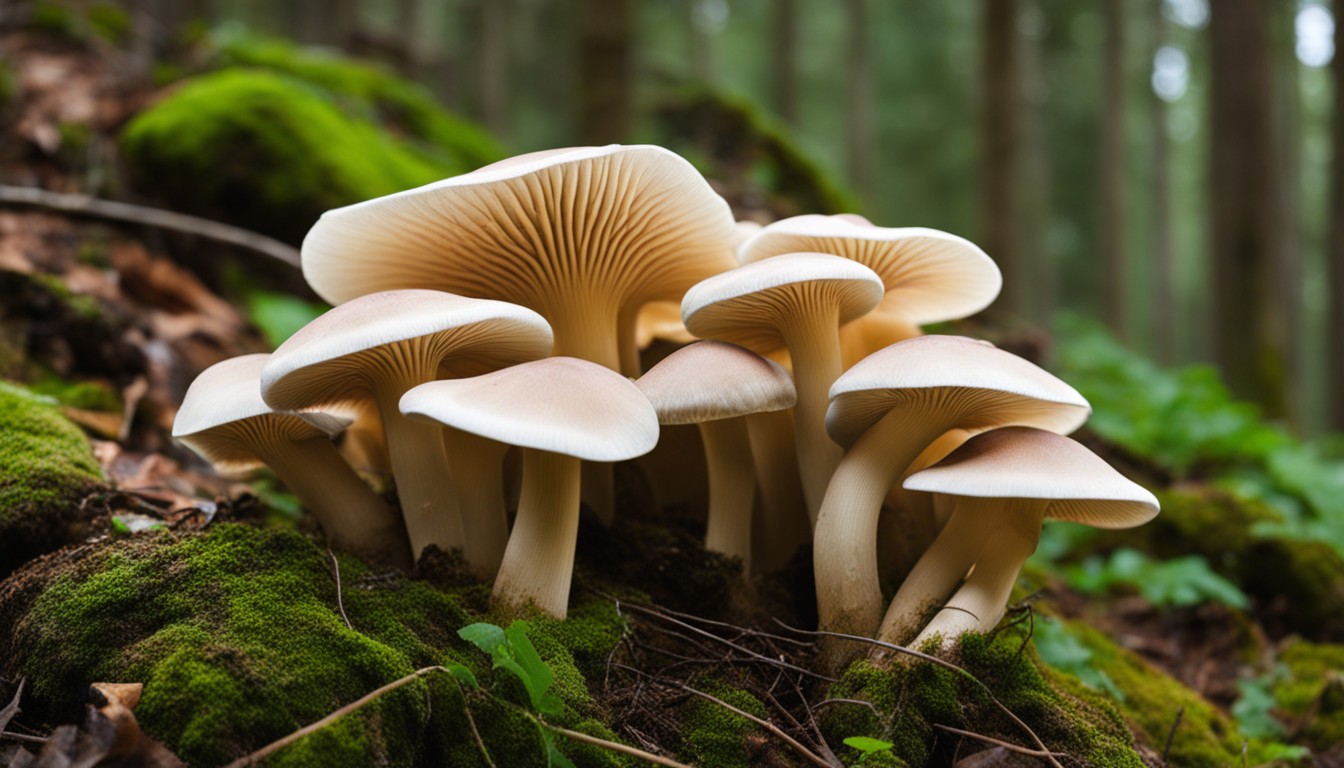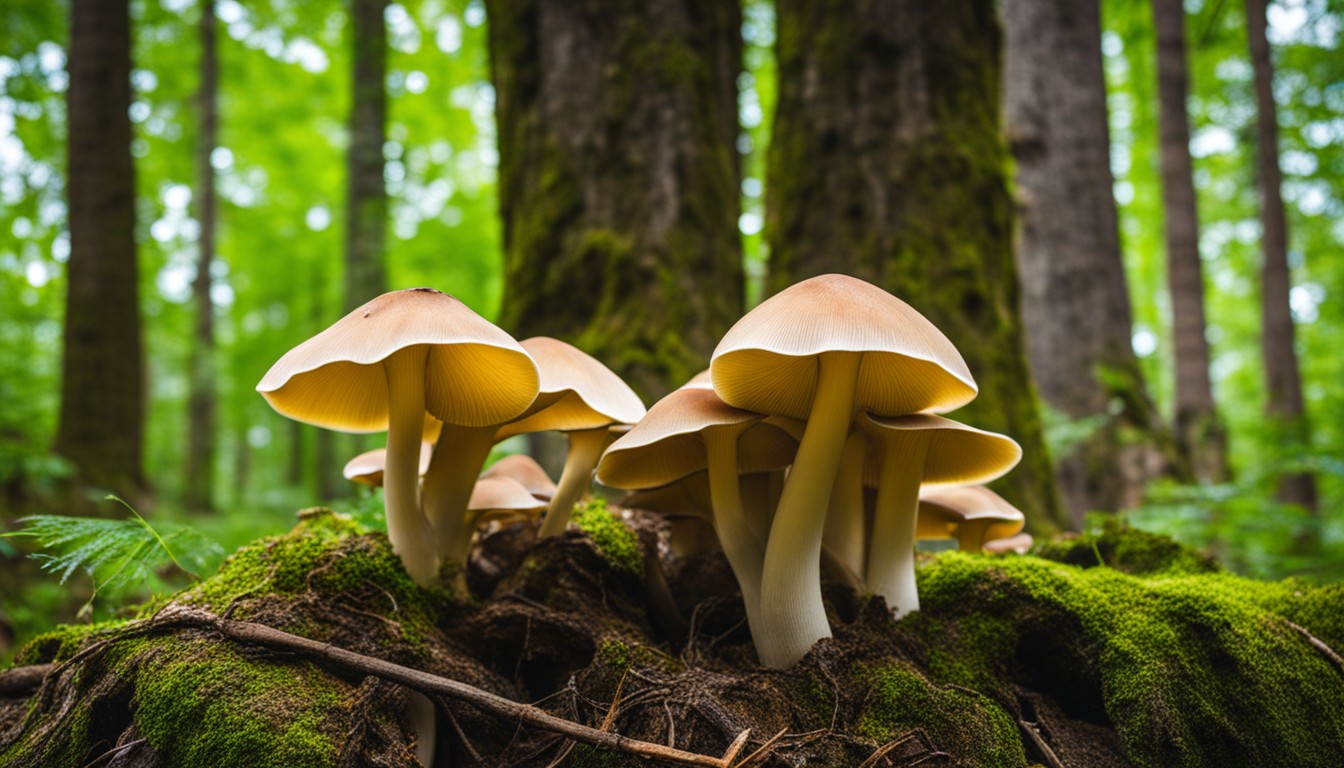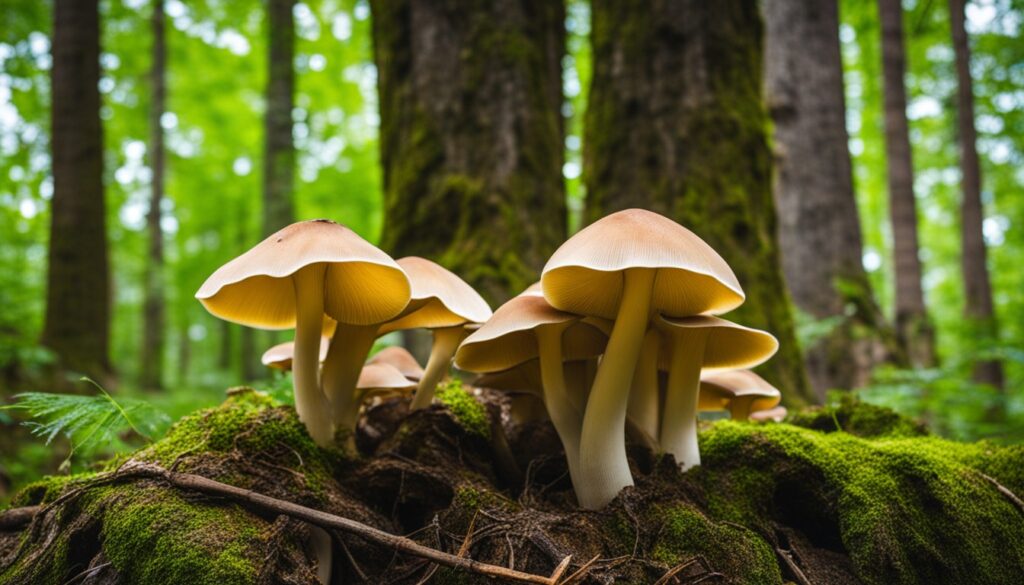Mushrooms are not just a summertime delight. Even in the colder months, there are plenty of opportunities to indulge in the earthy flavors of these intriguing fungi. If you’re wondering where to find mushrooms in winter, look no further. In this comprehensive guide, we’ll explore the best locations and techniques for foraging mushrooms during the winter season. From the snowy forests of the Pacific Northwest to the misty woodlands of the Appalachian Mountains, we’ll take you on a journey to uncover the hidden gems that await you.
Firstly, it’s important to understand the unique characteristics of winter mushrooms. While some species go dormant during this time, others thrive in the cold weather and even require a frost to trigger their growth. By familiarizing yourself with the different types of winter mushrooms and their preferred habitats, you’ll increase your chances of a successful foraging expedition.
Next, we’ll delve into the top foraging spots for winter mushrooms across the United States. Whether you’re located on the East Coast, West Coast, or somewhere in between, there are prime mushroom-hunting areas waiting to be explored. We’ll provide insider tips on specific national parks, forests, and wilderness areas known for their abundant winter mushroom populations.
But it’s not just about knowing where to go – you also need to know how to find and identify winter mushrooms. Our guide will equip you with essential tips and techniques to spot these elusive treasures among the winter foliage. From identifying key mushroom features to understanding the role of symbiotic relationships with trees, we’ll help you sharpen your mushroom identification skills.
Of course, safety is paramount when foraging mushrooms, especially during the winter months. We’ll cover important guidelines to follow, such as avoiding poisonous look-alikes and properly storing and preparing your harvested mushrooms. Your enjoyment of these seasonal delicacies should always be accompanied by caution and knowledge.
Finally, we’ll inspire you with enticing recipes and cooking ideas to elevate your winter mushroom experiences. From hearty soups and stews to flavorful sautés and risottos, we’ll provide a range of culinary options to make the most of your foraged finds.
So bundle up, grab your basket, and join us on a winter mushroom adventure you won’t soon forget. Whether you’re an experienced forager or just starting out, this guide will arm you with the knowledge and enthusiasm to embark on a rewarding journey into the world of winter mushrooms. Let the hunt begin!
Why Mushrooms in Winter are Special
Delving into the mystical world of winter mushrooms, one encounters a rich tapestry of unexpected flavors and intriguing growth patterns. These chilly season gems have a charm all their own, offering culinary and health benefits not found in their fair-weather counterparts.
What sets winter mushrooms apart is their ability to tough it out in freezing temperatures. Their unique composition allows them to thrive in chilly conditions, infusing them with distinct tastes and a texture that mushroom enthusiasts treasure. Toasty soups, savory roasts, or fresh salads—winter mushrooms add a fascinating twist.
Understanding the Seasonal Cycle of Mushrooms
Unlike plants, mushrooms do not rely on sunlight to grow, which is why they can thrive in the dark winter months. They have a fascinating lifecycle that includes a dormant period followed by a vigorous growth stage in colder conditions.
Mushrooms present an intriguing diversity throughout the year, displaying different appearances and flavors, due to their unique growth cycle dictated by weather rather than sunlight
To comprehend the seasonal transformations of mushrooms, it’s crucial to grasp their pattern of sporulation, which is highly influenced by weather. Mushrooms across the year exhibit varied appearances, tastes, and textures in accordance with their respective growth cycles.
The Unique Flavors of Winter Mushrooms
Discover the joy of eating winter mushrooms – they come with a depth of flavor unmatched by their summer counterparts. Their robust taste, earthy notes, and complex umami profiles are sure to take any meal to new culinary heights.
Each variety of winter mushroom has a unique flavor profile, providing a smorgasbord of gastronomical experiences. Compared to summer varieties, they are generally more savory, nutty and hearty – a perfect addition to winter meals.
From the pungent and intense black truffles to the subtly sweet Lion’s Mane, winter mushrooms offer a remarkable range of flavors. This diversity not only delights your palate but will make your winter dishes the talk of each gathering or meal.
Health Benefits of Winter Mushrooms
Winter mushrooms are regarded as superfoods due to their impressive nutritional composition. They are rich in antioxidants, fiber, and essential vitamins such as Vitamin D, B, and selenium that bolster immunity, especially during the colder months.
These unique fungi also house beneficial compounds such as beta-glucans that have proven positive effects on heart health, blood sugar regulation, and even reducing inflammation.
Including winter mushrooms in your diet does not only introduce unique flavors to your meals but also provides immense health benefits. Regular consumption can lead to improved digestion, better overall immunity, and can be useful for those managing weight and chronic conditions.
Popular Winter Mushroom Varieties

Accentuating the allure of the frost-kissed landscape, winter mushroom varieties come to the fore, each with their unique attributes. From the rare Black Truffle to the frost-resilient Chaga, these fungi have been hailed for their flavors and health benefits.
A seasonal exploration of mushrooms can lead foragers to a treasure of sought-after varieties such as Lion’s Mane and Maitake, making for idyllic gourmet ingredients or medicinal remedies. Appreciating the distinctive characteristics of each variety can open up a whole new world of craving-fulfilling and immunity-boosting winter delicacies.
Black Truffle (Tuber melanosporum)
Black winter truffles, extravagantly known as ‘black diamonds’ among culinary fans, exude an incomparable aroma and flavor. Their rich, earthy taste is a culinary treasure, appreciated for its richness and complexity to elevate any dish.
Discovering this gem requires expertise and patience. The truffle grows symbiotically with specific tree types, primarily oak and hazelnut, buried just below the soil surface in calcareous lands, a unique habitat driving their scarcity and value.
Truffle hunting, an ancient tradition, is a closely-guarded secret, usually accomplished with dogs trained to sniff out these subterranean treasures. Harvesting requires a gentle hand to prevent damaging the delicate structures and preserving the surrounding soil ecosystem.
The charm of black truffle not only lies in its distinct flavor and aroma but in the adventure involved in their discovery. This gastronomic marvel, hidden in cold winter soils, provides foragers with an exciting and rewarding quest each winter season.
Lion’s Mane (Hericium erinaceus)
Lion’s Mane, a winter species of mushroom known for its unique, cascade-like growth pattern resembling a mane, holds a special appeal. Animating woodland landscapes throughout the colder months, they are intriguing not only for their aesthetic charm but also for their nutritional potency.
Hericium erinaceus, or Lion’s Mane, is packed with bioactive substances beneficial to human health. Revered for their neuroprotective properties, these mushrooms have been linked to supporting cognitive functions and aiding digestion.
On the hunt for Lion’s Mane, mushroom enthusiasts should focus on hardwood trees and fallen logs. They often grow on wounds of living trees, presenting a striking contrast to the winter landscape with their large, white, shaggy clusters.
To identify Lion’s Mane in the wild, look for its characteristic spinelike projections hanging in clusters. They do not have a traditional mushroom cap but display a clump of white, spindly strands resembling a waterfall.
Although their unique appeal favors discovery, a mindful harvesting approach is key. Avoid removing the fungi entirely from their host, ensuring that they continue to serve as a winter haven for a variety of wildlife and can grow again in future.
Maitake (Grifola frondosa)
Observe maitake in its natural surroundings, you’ll notice it growing in ruffled clusters on the base of deciduous trees. Its texture is firm yet supple, and it’s favored in kitchens for its unique savory flavor, often used in stir-fries or soups due to its resilience against disintegration.
When pursuing maitake, timing is critical as they flourish in autumn and winter seasons. These mushrooms grow predominantly in Northeastern parts of the USA, though they can also be found in Europe and Asia.
A hardwood forest is an ideal ground for finding maitake mushrooms. Search near the base of oak, elm, maple, or chestnut trees. Unlike many mushrooms, maitake grows directly on the tree rather than the forest floor.
While fresh maitake mushrooms are a rare treasure, their taste and culinary versatility justify the hunt. Safety precautions like carrying a field guide for proper identification and foraging in permissible areas significantly enhance the experience.
Chaga (Inonotus obliquus)
Chaga, also known as the King of Mushrooms, is an extremely beneficial variety, reputed for its potent immuno-stimulating properties. The hard, black exterior hides an array of antioxidants and nutrients. Harvesting requires careful observation and a sharp tool to gently pry it off the bark of senescent or dying birch trees.
Chaga is typically found in colder climates, especially those with birch forests. In the USA, seek this winter mushroom in the North-East area, from Maine through Pennsylvania. It’s found growing on mature birch trees, favoring those that are damaged or dying.
Your best ally in finding Chaga is patience. It can sometimes look like a blackened burl on the tree trunk, easily overlooked. But once spotted, the rewards are worth the effort, and careful, sustainable harvesting ensures future growth and abundance.
Optimal Conditions for Finding Winter Mushrooms

Winter mushrooms thrive under certain conditions, including location and climate. Notably, damp, cool weather and environments rich in decaying wood or leafy material offer the most favorable conditions for their growth.
When embarking on mushroom foraging during winter, arm yourself with the necessary tools, techniques, and knowledge. Generally, using a quality mushroom field guide, understanding mushroom growth patterns, and using the right harvesting equipment ensures a successful forage.
Temperature and Weather Considerations
The weather patterns drastically impact the harvesting of winter mushrooms. Temperature fluctuations, precipitation, and other atmospheric changes have a significant influence on mushroom proliferation.
Cold weather doesn’t pose a hindrance to mushroom growth; in fact, certain varieties thrive optimally in low-temperature, high-moisture conditions. These discerning characteristics make winter mushrooms exceptionally exclusive.
Contrary to common understanding, the relationship between temperature and mushroom growth is not linear. While most fungi despise extreme cold, winter mushrooms prefer slight to moderate freezing conditions for ideal growth.
Understanding these weather dependencies is crucial for successful scouting. Ideal conditions typically involve a cycle of freeze-thaw, where daytime temperatures are slightly above freezing, and nighttime brings mild frost.
Interestingly, a snow-covered landscape can benefit mushroom hunters. The snow acts as an insulator, protecting the mushroom mycelium just beneath the ground from extreme cold, thereby fostering mushroom growth.
Habitat and Growing Conditions
Though winter mushrooms, particularly types like truffles and maitake, thrive in colder climates, the critical aspect lays in the moisture content of the soil, supply of organic matter, and adequate shade. Ideal terrain includes rich forest floors, dead or dying trees, and substrates strewn with leaf litter or fallen logs.
Diversity in habitat leads to variations in mushroom species. Different areas may foster different types of fungi, depending on elements like elevation, tree species present, and soil composition. Exploring varied terrain when foraging, therefore, can uncover a broader array of winter mushroom specimens.
Identifying Signs of Mushroom Growth
Decoding signs of mushroom growth during winter requires a trained eye and detailed understanding. Look out for earth disturbances, peculiar lumps in the ground, or even fruits sprouting directly from the tree bark.
Examining decaying wood areas can help spot winter mushroom growth. These fungi favor moist, rotting logs or stumps, flourishing amidst the decay to extract necessary nutrients.
Layers of snow can provide a perfect environment for mushroom mycelium. Check beneath the snow blanket in wooded areas, as certain mushroom varieties can survive and thrive in these colder conditions.
Paying attention to changes in the surroundings is crucial. A sudden abundance of insects, especially flies or slugs, may indicate potential mushroom growth underneath.
Best Locations for Mushroom Hunting in Winter

Discovering prime locations for winter mushroom hunting can be as rewarding as finding the mushrooms themselves. Look for moist, woody areas rich in leaf litter, in places such as national parks and secluded woodland trails.
Venturing out to top mushroom foraging destinations this winter? Consider the bounty of national forests, and don’t forget about less-traveled trails. Fallen trees and leaf debris often hold hidden mushroom-filled treasures waiting to be unearthed.
National Forests and Parks
The U.S. National Forests are mushroom scouting havens; their diverse ecosystem and varied geography offer an impressive array of winter mushroom varieties. Winter mushrooms thrive here due to the forests’ rich organic materials and subtropical regions. Whether you’re a seasoned forager or a novice, these forests provide exciting opportunities for mushroom hunting.
Exploring National Parks in winter may reveal an abundant harvest of seasonal mushrooms. The parks’ dense woodlands, infused with decomposing organic matter, and prevailing cooler climates are ideal for mushrooms’ growth. It presents both a thrilling adventure and a chance to witness the earth’s winter bounty.
Remember, when foraging in National Parks or Forests, to respect the rules and regulations put in place. These rules are intended to protect our natural resources, ensuring the sustainability of the mushroom populations for future generations to enjoy. Be aware and respectful of these places as you unlock the secrets of winter mushrooms.
Wooded Areas and Trails
Foraging for winter mushrooms can prove fruitful in a variety of the United States’ wooded areas. Prime locations include the Pacific Northwest, reputed for its lush, damp forests amiable to mushroom growth, and the North Eastern region, enveloped by diverse woodlands brimming with fungal delights.
Surviving trekking trails offer the mushroom forager an opportunities to uncover plentiful mushroom populations. These trails provide the perfect intersection between accessible paths and undisturbed fungus-rich habitats.
When you trail through woods, keep your eyes open for fallen logs and tree stumps, these can often act as hosts to various species of winter mushrooms. They offer shelter and feeding grounds, nurturing mushrooms to maturity during the chilling winter months.
Guided mushroom foraging tours are an exceptional choice for enthusiasts who wish to combine the beauty of trail hiking with the thrill of mushroom hunting. Organizations in areas like the Great Smoky Mountains, Olympic Peninsula, and Pennsylvania woods regularly arrange such enriching adventures.
Understanding the kind of woods that specific varieties of winter mushrooms prefer can significantly maximize your foray. For instance, Maitake mushrooms show greater affinity towards oak trees while Chaga mushrooms are seldom found on birch trees.
Fallen Trees and Leaf Litter
In nature, mushrooms play an essential role in recycling organic matter, with decaying logs often serving as an ideal host. Several winter mushroom species, particularly Lion’s Mane and Maitake, favor these fallen trees, releasing their spores into the cold air, which results in fruitions that are not just unique but also more nutritious.
Leaf litter provides another unexpected habitat for some winter mushroom varieties. As leaves fall and rot on the ground, they create a rich environment where fungi prosper, generating a nutrient-rich and moist substrate that winter mushrooms like Chaga thrive in.
Spotting mushrooms in leaf litter may require a trained eye due to the natural camouflage resulting from the interplay of leaves and fungi coloration. Look for unusual shapes or color disruptions in the leaf blanket, which could be a sign of mushroom growth beneath.
Studying the behavior of fungi helps understand their connection with their eco-system better, consequently improving your chances of finding them. A fruitful mushroom hunt requires understanding that fallen trees and leaf litter aren’t merely debris but vital playing factors in the cultivation and emergence of winter mushrooms.
Secret Spots Shared by Experienced Foragers
For the committed mushroom forager, fellow enthusiasts’ shared wisdom is gold. These insiders often divulge about protected locations abounding with nature’s bounties – a reward for their efforts in building a conscious and responsible foraging community.
Seasoned foragers, in sharing the fruits of their years of experience, unravel the best-kept secrets. Discover the corners abundant in winter mushrooms, from the undergrowth of a secluded forest to a quietly humming park trail, fostering a deeper understanding of nature’s cycles.
Tips for Safely Harvesting and Preparing Winter Mushrooms
To ensure a safe foraging experience, it’s paramount to use a reputable field guide and to be aware of poisonous mushrooms that may bear a striking resemblance to edible ones. Familiarize yourself with telltale signs of both edible and toxic mushroom varieties for your safety.
When preparing winter mushroom delicacies, cleanliness is essential. Start by gently brushing off any dirt or debris without rinsing in water as this could result in a soggy texture. Cook mushrooms thoroughly to unlock their unique flavors and ensure they are safe for consumption.
Using a Mushroom Field Guide
Harnessing the power of a mushroom field guide is crucial when foraging for winter fungi. This essential tool provides detailed insights for identification, assisting in spotting particular winter varieties effectively while ensuring accident-free foraging.
The field guide unlocks the world of mycology, detailing nuances like gill patterns, caps, and spore print – essential characteristics to differentiate between varieties. Using a mushroom field guide, you increase your chances of successful winter foraging, spotting choice edibles and avoiding poisonous cousins.
Moreover, a field guide focuses on local mushrooms, adapting to the region’s mycological biome. So, it is most useful for foragers in search of winter varieties, spotlighting species that flourish in the cold.
Some guides feature a variety of applications such as preserving, cooking, and medicinal uses. Utilizing this information can greatly influence your foraging efforts, guiding not only what to pick but how best to use the harvest.
Therefore, a mushroom field guide isn’t merely a book; it’s a forager’s lifeline. It allows you to navigate the winter woods armed with knowledge, transforming the experience from a random search into a focused, rewarding endeavor.
Avoiding Poisonous Look-Alikes
Paying close attention to visual details is key when distinguishing edible winter mushrooms from their poisonous counterparts. Color, shape, pattern markings, and size can be indicative of a mushroom’s safety for consumption.
Dangerous doppelgängers of edible mushrooms are not uncommon in nature. Some deadly winter mushrooms closely resemble their harmless counterparts, making wrong identification an adverse risk for foragers.
Possessing knowledge on the specific characteristics of poisonous mushrooms is critical. This includes understanding the different physical and sensory properties that could signal a potentially harmful variety.
Your health is paramount. If in doubt about a mushroom’s edibility, it is prudent to err on the side of caution. Even professionally trained mycologists sometimes make identification errors.
Utilizing resources such as mushroom field guides or mobile applications can additionally bolster your ability to tell safe mushrooms from harmful ones. These tools offer extensive knowledge on physical properties, habitat indicators, and growth patterns.
Delicious Winter Mushroom Recipes
Winter mushroom recipes not only warm the stomach, but the heart as well. These unique, seasonal fungi can transform ordinary dishes into gourmet feasts, whether they’re featured in a hearty stew, a delicate risotto, or a flavorful stir-fry.
- Creating a warming black truffle infused broth, perfect to enrich any soup or stew
- Whipping up a creamy Lion’s Mane mushroom risotto, bringing comfort on a cold night
- Roasted Maitake mushrooms, a simple side dish or topping full of umami
- Brewing a cup of Chaga mushroom tea, a unique hot beverage known for its health benefits
Frequently Asked Questions
Where can I find mushrooms in winter?
In winter, mushrooms can be found in a variety of locations, including snowy forests, damp woodlands, and even urban environments with suitable growing conditions. Keep an eye out for fallen logs, decaying leaves, and the base of trees, as these are often prime spots for mushroom growth during the colder months. Remember to respect nature and obtain necessary permits or permissions when foraging on public or private lands.
What are some popular types of winter mushrooms?
Winter mushrooms come in an array of fascinating species, each with its own unique characteristics and flavors. Some popular types include the Velvet Shank, known for its rich flavor and velvety texture; the Winter Chanterelle, highly prized for its fruity aroma and delicate taste; and the Lion’s Mane, which boasts a striking resemblance to a lion’s mane and a sweet, seafood-like flavor.
How can I identify winter mushrooms?
Identifying winter mushrooms requires a keen eye and attention to detail. When gathering mushrooms, observe their color, shape, size, and texture. Take note of key features such as gills, pores, or spines, and compare them to reliable field guides or consult with experienced foragers who can provide guidance. Remember that proper identification is essential for a safe and enjoyable foraging experience.
Are there any safety considerations when foraging winter mushrooms?
Yes, safety is of utmost importance when foraging mushrooms, regardless of the season. It is crucial to exercise caution and follow best practices to avoid any potential hazards. Be aware of toxic look-alikes, as they can be present in the same environments as edible mushrooms. If you are uncertain about the edibility of a mushroom, it is recommended to consult with mycology experts or experienced foragers who can offer guidance. Additionally, always harvest mushrooms from areas free of pollution and contaminants.
What are some delicious ways to cook winter mushrooms?
Winter mushrooms offer a world of culinary possibilities. Their robust flavors and unique textures make them ideal for various dishes. Sauté winter mushrooms with garlic and herbs for a simple and flavorful side dish, or incorporate them into hearty soups and stews to add depth and earthiness. Another popular option is to incorporate them into risottos, pasta dishes, or even vegetarian mains. Get creative in the kitchen and let the rich flavors of winter mushrooms elevate your winter dining experiences.
Conclusion
In conclusion, winter mushrooms offer a unique combination of culinary versatility and vitality, deserving their own special place in both our meals and our mushroom hunting trips. Keep in mind the advice provided; discovering these winter season delicacies can be both a rewarding and appetizing adventure.
- Understanding the seasonal cycle of mushrooms.
- Familiarizing oneself with popular winter mushroom varieties such as Black Truffle, Lion’s Mane, Maitake, and Chaga.
- Knowing the optimal conditions and identifying signs of mushroom growth.
- Venturing out to promising locations for finding mushrooms in winter.
- Following tips for safely harvesting and preparing these Winter Mushrooms.

